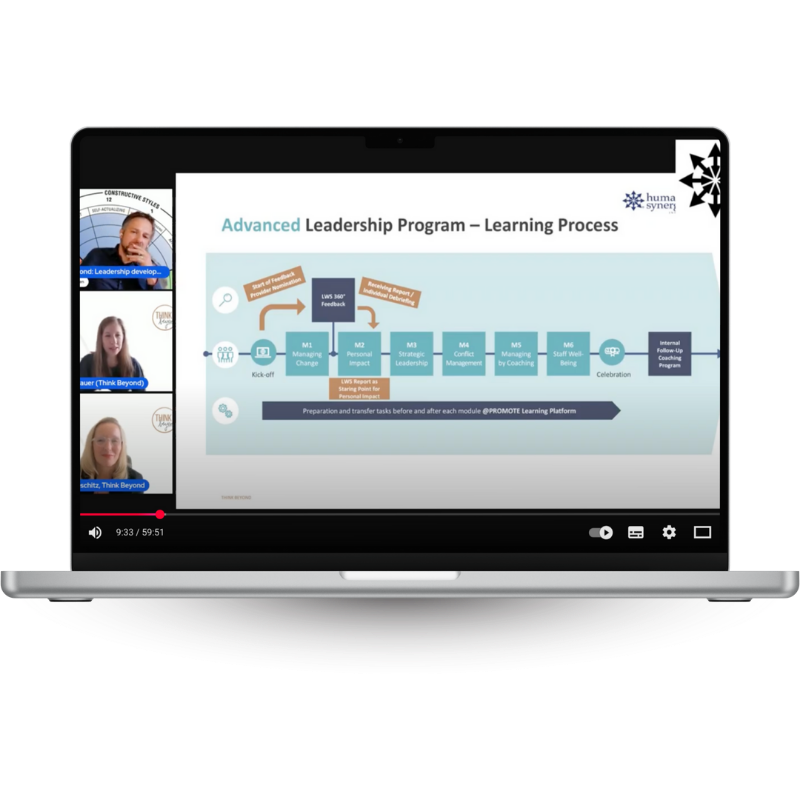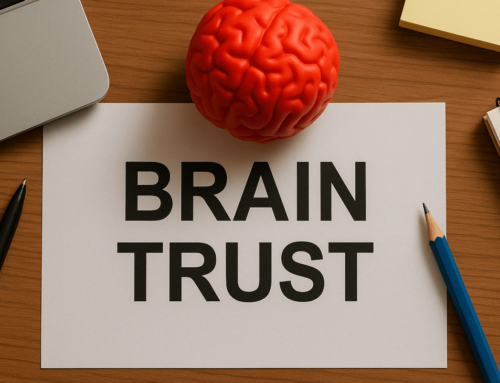Sometimes it's just frustrating: People attend our carefully designed leadership development programs, they seem engaged during the sessions, they nod enthusiastically about implementing changes… and then they return to their desks. A few weeks later, when we check in with their teams, nobody has noticed any difference. Ever happened to you?
In Leadership Development – as in all initiatives that target incremental change – this is our most persistent challenge. We can deliver world-class content, bring in expert facilitators, and secure executive buy-in. But if our programs don't translate into actual behavioral change in the day-to-day reality of leadership, we haven't truly succeeded. Needless to say: It's not the leaders who fail. But the system that didn't create the environment for lasting change to happen.
The good news? We've discovered a powerful example of what's possible. A 12-month advanced leadership program—highly tailored to one organization's specific challenges—is showing us what becomes possible when you combine the LWS (Leadership/Work Styles) instrument with deliberate transfer design. This isn't a program you'd copy exactly, but it beautifully illustrates the principles that make leadership development stick.
Over this four-part blog series, we'll unpack exactly how this works. In this first part, we're addressing the fundamental problem and introducing the solution framework. In Parts 2, 3, and 4, we'll explore why LWS specifically creates breakthrough moments, how to measure impact, and the critical questions to ask before designing your own approach. Ready? Let's dive in.
Table of contents
- 1. The Fundamental Problem: Events vs. Journeys
- 2. What Makes This Different: The Integration Principle
- 3. The Tool That Makes It Tangible: Why LWS?
- 4. The Counterintuitive Insight: Timing and Trust
- 6. One Example of How This Unfolds: A 12-Month Journey
- 7. What We’re Seeing: Early Indicators of Success
- 8. The Question That Matters Most
- The Invitation
1. The Fundamental Problem: Events vs. Journeys
Here’s the uncomfortable truth: Most leadership development programs are designed as events, not journeys. We pull leaders out of their work context, deliver great content over one or two days, maybe add a 360° feedback tool, and hope for the best. Then we measure success by asking, “Did you enjoy the program?” and “Would you recommend it to others?”
Please excuse the exaggeration here, but you know what we mean, right?
Enjoyment and intention don’t equal behavior change. The real question we should be asking is: “Three months later, what are you doing differently? And more importantly, what has your team noticed?” When we ask that question honestly, the results are often disappointing. Not because our content isn’t good, but because we’re not designing for the messy, complex reality of how adults actually change their behavior.
2. What Makes This Different: The Integration Principle
The program we’re examining takes a fundamentally different approach built on one core principle: Integration over isolation. Many very good leadership programs out there exist in a bubble. They’re disconnected from the day-to-day realities leaders face, from the organizational systems that shape behavior, or from the ongoing support structures that could sustain change.
Here are three factors for programs who overcome that challenge:
1. They Connect to What Already Matters
An integrated program isn’t floating in space – it’s deliberately woven into the fabric of how the organization actually operates:
- Mission and values: The development themes directly reinforce what the organization says it stands for
- People strategy: Leadership capabilities align with strategic talent priorities
- Competency framework: Skills developed in the program mirror what’s expected in performance conversations
- Well-being initiatives: Staff well-being is an explicit program module, not an afterthought
- Performance management: Development goals from the program flow into ongoing performance dialogues
When everything points in the same direction, change becomes exponentially easier. Leaders aren’t being asked to adopt behaviors that conflict with what they’re measured on or what their organization rewards.
2. They Provide Structure for Transfer
Here’s where many programs falter: We assume that if we deliver good content, motivated leaders will figure out how to apply it.
But hope isn’t a strategy. Transfer design is.
The case study we’re referring to uses a digital platform that guides participants through the entire journey. Between each module, leaders receive specific transfer tasks – not vague suggestions like “practice active listening,” but concrete assignments like:
- Implement the specific action plan from your LWS feedback
- Share your development goals with relevant stakeholder groups
- Apply this month’s content to a real business challenge you’re facing
- Report back to your cohort on what you tried and what you learned
3. They Build a Bridge to Ongoing Support
The program concludes with an internal follow-up coaching process. Not external consultants who disappear after the contract ends, but internal coaches who are part of the organizational fabric and can provide sustained support. This matters enormously. Leaders know that their development doesn’t end when the formal program does. There’s a structure in place to help them continue working on challenges, celebrate progress, and get support when they hit obstacles.
3. The Tool That Makes It Tangible: Why LWS?
Let’s talk about the role of 360° feedback in this journey, because not all feedback tools are created equal.
This program uses LWS (Leadership/Work Styles) – a scientifically validated 360° instrument that’s fundamentally different from typical feedback surveys. Here’s what makes it distinctive:
- It’s normed specifically for leaders. While some 360° tools try to be everything to everyone, LWS is designed exclusively for people in leadership roles. When you get feedback, you’re being compared to a global database of other leaders, not a generic population. For leadership development, this specificity matters.
- It’s globally validated. This is critical for multinational organizations. LWS has been validated across cultures and is delivered in over 20 languages. When you’re developing leaders across different regions, you need a tool that accounts for cultural nuances while maintaining a consistent framework for what effective leadership looks like.
- It connects to a proven behavioral framework. LWS isn’t just collecting opinions about whether people like your leadership style. It measures behaviors against the Circumplex – a research-based model that maps constructive, passive-defensive, and aggressive-defensive leadership patterns. This gives leaders not just data, but a roadmap for development.
- It’s designed for development, not evaluation. Some 360° tools feel like a performance review from multiple angles. LWS is explicitly positioned as a growth tool. The language, the framing, the action-planning components – everything signals “this is about becoming more effective,” not “this is about judging you.”
This distinction matters enormously for how leaders receive and use their feedback. When the tool itself communicates development over evaluation, leaders are more open, more curious, and more willing to work on challenging areas.
4. The Counterintuitive Insight: Timing and Trust
Here's something that might surprise you: In this program, the 360° feedback doesn't come first. Our instinct as L&D professionals is often to start with assessment. Get the data, understand the gaps, then design interventions. It's logical. It's systematic. And for leadership development in a cohort model, it's wrong.
Here's why:
The Trust Problem
When you ask leaders to share vulnerable insights about their development areas before they've built trust with their cohort, you get surface-level sharing and guarded conversations. Leaders are smart. They know that the people in the room might be peers they'll collaborate with for years. They're not going to be truly open about their struggles with conflict avoidance or their tendency to micromanage until they know it's safe.
The Solution: Flip the Script
A practical solution we used in this case study program: The LWS feedback happens between Module 1 and Module 2. Here's the flow:
Module 1: Managing Change – Leaders dive into a topic deeply connected to the organization's current transformation. They work on real business challenges they're facing right now. They get to know each other. They see that this isn't theoretical fluff but practical support for actual work. By the end of Module 1, trust has been established. Leaders have seen their peers grapple with real challenges. They've experienced that this is a safe space for authentic development.
Between Modules 1 and 2: Leaders complete their LWS assessment, invite feedback providers (team members, peers, managers), and receive their reports. Critically, they have the option for individual coaching to process their results before bringing them to the group.
Module 2: Personal Impact – Now, when leaders come together to explore their LWS feedback, they're entering a space where psychological safety exists. They've already built relationships. They know this group is here to support development, not judge weaknesses. We noticed: The difference in the quality of conversation is remarkable. As one of the program facilitators shared:
"At the beginning, we tried it the other way around – starting with LWS in Module 1. It worked, but this sequence works much better. People are much more open to diving deeper and really working with each other on their feedback when trust has been established first."
5. What This Looks Like in Practice
Let’s bring this to life with what actually happens in this program. The cohort is made up of senior leaders from across the organization – not necessarily people who work together daily, but leaders at similar levels facing similar challenges. They’re experienced professionals who’ve been in leadership roles for years. In Module 1, they tackle change management using real transformation challenges the organization is facing. No hypothetical case studies – actual strategic shifts, restructures, and change initiatives they’re leading or affected by. Through this work, something important happens: Leaders see each other as competent professionals dealing with complex challenges. They witness vulnerability (admitting when change is hard, when teams are resistant, when they’re not sure of the right approach) in a context that feels normal and safe.
Then comes the LWS feedback.
Some leaders take advantage of individual coaching to process their reports. Maybe they’re surprised by something in the feedback. Maybe they want to think through how to share it with the group. Maybe they just want to talk through their action plan with someone first. Others feel the report is comprehensive and clear enough that they’re ready to bring it directly to Module 2. The key is choice and timing. Leaders control what they share and when – but they’re doing it in a context where trust already exists.
In Module 2, the conversations go deep. Leaders share insights like:
“I had no idea I was perceived as micromanaging. I thought I was being supportive, but now I understand why my team might experience it differently.”
These moments of genuine recognition – what psychologists call optimal dissonance – are where real development begins. Not superficial “I should probably delegate more” insights, but profound “oh, this pattern I’ve been running is actually undermining what I’m trying to accomplish” realizations. And because it’s happening in a cohort, leaders aren’t alone with these insights. They have peers who are on the same journey, who can share strategies, who can check in on progress, and who can celebrate wins.
6. One Example of How This Unfolds: A 12-Month Journey
To illustrate what’s possible, let’s look at one example of how this plays out over 12 months. This isn’t a blueprint to copy—your organization’s design will look different based on your context, culture, and challenges. But seeing one thoughtful approach helps clarify the principles:
- Managing Change – Ground in organizational reality, build trust
- Personal Impact + LWS – The mirror: understanding your current leadership patterns
- Strategic Leadership – Elevate perspective and create a constructive culture
- Conflict Management – Apply insights to how you handle difficult conversations
- Managing by Coaching – Leverage feedback to consciously coach others
- Staff Well-being – Circle back to collaboration, feedback, and culture
- Celebration + Internal Coaching Follow-up – Continue the journey with ongoing support
Notice the pattern? After leaders receive their LWS feedback in Module 2, every subsequent module of the leadership development program gives them another lens through which to examine and apply those insights. The feedback about their leadership style isn’t something they look at once and file away. It’s a mirror they keep returning to, each time with new understanding based on the topic they’re exploring. By Module 6, leaders have examined their behavioral patterns through the lenses of change, strategy, conflict, coaching, and wellbeing. The integration is profound. Again, this specific structure emerged from this organization’s unique needs—their transformation challenges, their culture, their readiness for feedback. Your program might have different modules, different sequencing, or different focus areas. What matters isn’t copying this structure, but understanding the principles: integration, timing for trust, continuous application of insights, and long-term commitment.
7. What We’re Seeing: Early Indicators of Success
Even before we get to formal re-measurement (which we’ll cover in Part 3), there are powerful indicators that this approach works. These results aren’t about this specific six-module structure being “the right way.” They’re about what becomes possible when you design with discipline—when you integrate with organizational systems, use scientifically valid tools, build trust before asking for vulnerability, and commit to long-term journeys rather than one-shot events.
Leaders are engaged differently. According to facilitators, participants “seriously work again and again with the topics they got as feedback at the beginning, in connection with the modules that follow. The doors get more and more opened, and the interest grows.”
Stakeholders notice immediately. One of the program designers emphasized: “We work constantly on real-life situations. In an ideal world, every participant leaves a workshop and their stakeholders notice that something happened.”
The demand is spreading organically. After experiencing LWS in this context, leaders are asking if they can use it with their own teams. Nobody is mandating this – it’s happening because leaders who’ve experienced the value of structured, science-based feedback want to create that same opportunity for others.
As the program sponsor noted:
“There’s more interest now in feedback than there might have been before, and that’s a very positive thing.”
This is how feedback culture spreads: not through top-down mandates, but through leaders who’ve experienced transformation and want to extend it.
8. The Question That Matters Most
Here's what we want you to think about as you consider your own leadership development programs: Are you designing for events or journeys? Events are contained. They have clear start and end dates. They're easy to budget, schedule, and measure (at least superficially). Journeys are messier. They require sustained commitment, multiple touchpoints, integration with organizational systems, and patience for change to take root. But only journeys create the kind of deep behavioral change that transforms leadership effectiveness.
The program we're examining proves that when you:
- Integrate development with organizational realities
- Use scientifically validated tools designed specifically for leadership
- Build trust before asking for vulnerability
- Create structure for ongoing application and support
- Design for the long arc of behavior change, not the short burst of information delivery
…you get results that actually stick.
The Invitation
We believe that leadership development can and should create real, measurable, sustained behavior change. Not just satisfied participants, but transformed leaders who show up differently and create better outcomes for their teams and organizations. This isn't idealistic thinking. It's what happens when we design with discipline, integrate with intention, and commit to the journey instead of settling for the event. We hope this series gives you both the inspiration and the practical insights to elevate your own leadership development programs—designed specifically for your organization's unique context and challenges.






